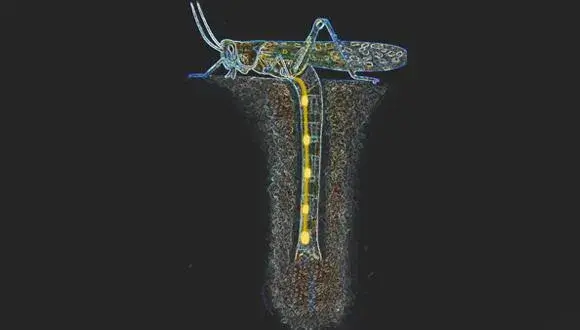The flexibility of her central nervous system allows her to stretch when laying her eggs in the soil to 2 or 3 times her original length, then quickly return to her normal length without damage

Every mother will do anything to know that her offspring are in a safe place. It turns out that the female locust can take it one step further: a new study by Tel Aviv University found that the central nervous system of the female locust has elastic properties, which allow it to stretch when laying eggs in the ground up to 2 or 3 times its original length, without being damaged Irreversible. The researchers: "We do not know of a similar ability in almost any living creature in nature. The human nervous system, for example, can stretch up to 30% without tearing or being permanently damaged." According to them, in the future the findings may contribute to new developments in the field of regenerative medicine, as a basis for nerve restoration, and the development of synthetic tissues.
shows flexibility
The study was conducted by a team of Tel Aviv University researchers led by Dr. Bat-El Panhsik from the School of Mechanical Engineering At the Ivy and Alder Fleishman Faculty of Engineering, and Prof. Amir Ily from the School of Zoology at the George S. Wise Faculty of Life Sciences. Dr. Rakesh Das from the School of Mechanical Engineering, Dr. Moshe Gershon from the School of Zoology, and Prof. Eran Perelson and Amjad Ibrahim also participated in the study. From the Department of Physiology and Pharmacology at the Sackler Faculty of Medicine.
"When the female locust wants to lay her eggs, she digs a hole in the ground that will give them protection and optimal conditions for hatching. For this purpose, it is equipped with a dedicated digging organ, which consists of two pairs of digging paws, which are located at the end of the abdomen, on both sides of the laying tube. While digging, the female extends her body, until sensors located along its length signal that she has reached a suitable point for spawning. Thus, an adult female, whose body length is about 4-5 cm, may stretch it for spawning to a length of 10-15 cm, then quickly return to its normal length, and lengthen again in the next spawn," explains Dr. Panhsik.
"The super ability of Nekval the locust is almost 'science fiction'. In nature in general, only two other examples of similar 'performances' are known: the whale's tongue, known as the 'big-headed whale', and a certain type of marine snail, whose nervous systems are able to lengthen significantly thanks to an accordion-like mechanism. We wanted to find out what is the biomechanical mechanism that gives the female locust its wonderful ability", says Prof. Ily.
The key to rehabilitation treatments and regenerative medicine?
As part of the study, the researchers removed their central nervous systems from female locusts, and placed them in a liquid that simulates the natural environment, under physiological conditions similar to those inside the body. Using highly sensitive measuring instruments, they measured the forces needed to extend the nervous system.
"Contrary to previous hypotheses and known examples, we did not find any accordion-like mechanism. We discovered that the nervous system of the female locust is made of an elastic material, which is able to elongate and then return by itself to its original state, ready for reuse, without causing any damage to the tissue. This is an almost incomprehensible finding from a biomechanical and morphological point of view," says Dr. Panhsik.
"This is a wonderful ability that is not known in any other animal. In follow-up studies, we will investigate the issue in depth, with the aim of identifying the specific mechanism that enables the unique feature. We hope that in the future our findings will help to develop synthetic tissues with high flexibility and to restore nerves in the treatments of regenerative medicine", Prof. Ely concludes.
More of the topic in Hayadan:
